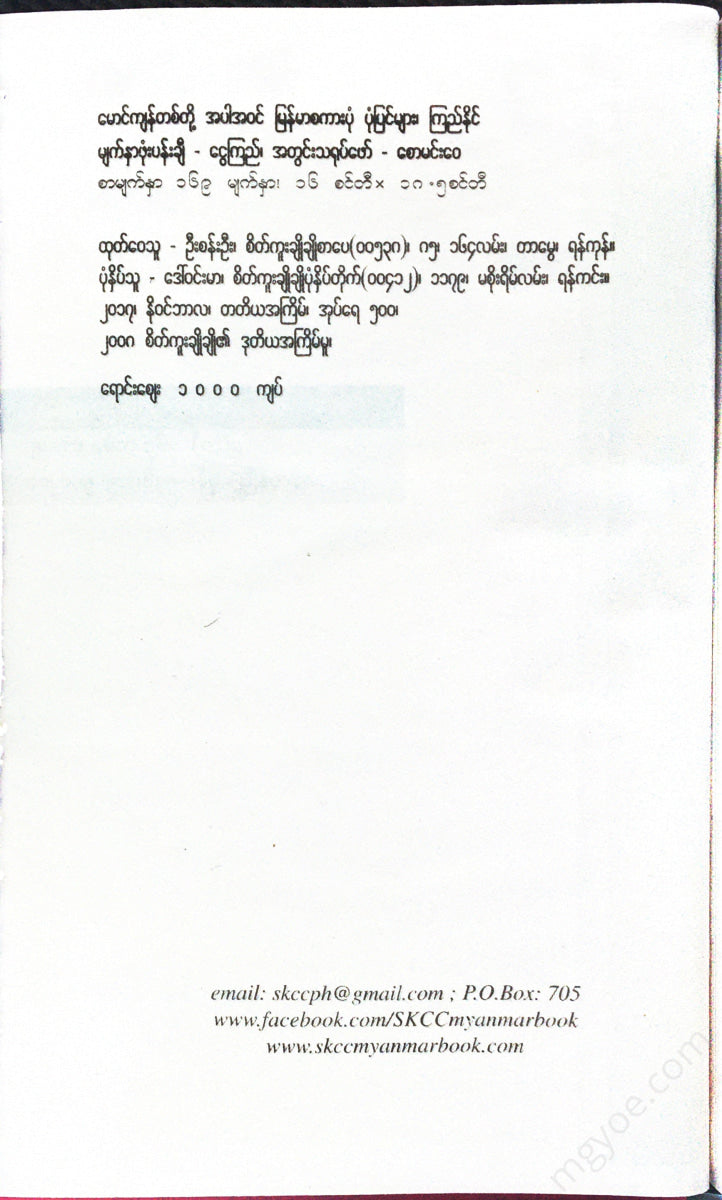စိတ်ကူးချိုချိုစာပေ
Kyi Naing - Myanmar proverbs including Maung Kyant
Kyi Naing - Myanmar proverbs including Maung Kyant
Couldn't load pickup availability
To Maung Kyant and his family
Now, “Maung Kyant and Other Myanmar Proverbs” is the second book of proverbs I have collected. The first book was published in August 1997. There were three years between the first and second books. The third book, “The Little Bird, the Wise One,” will also be published. The manuscript was completed around 1996. Many difficulties had to be overcome to become a book and reach the readers.
I don't want to talk about the difficulties here. Let me just tell you a little bit about how I found these stories.
Our childhood was filled with the joy of listening to stories in our grandmother's arms, and we will never forget it. When we were in school and when we grew up, we would search for storybooks and read them endlessly.
At school, I studied the Kantaw Min Kyaung Metta Sa, the Mahabharata, and Shakespearean stories. I loved them.
When I came into contact with the four verses of the poem, I started reading poems. Ummadanti Po, Magha Dewa Linka Thit, Ko Khan Po, Kye Kan Shin Gyi Metta Sa, U Punya Mat Metta Sa, etc.
Then, I realized that some of the phrases and proverbs in the advice and metaphors of the elders were commonly used in those poems. I noticed that proverbs and advice were linked together.
There are many proverbs about Kantaw Min Kyaung, Taung Phila, Kyi Thae Lay Dat, Lone Daw, Nyaung Pin Tha, Kye Kan Shin Gyi, Po Thu Taw U Nu, Pok Kan Maung Cho, etc.
Originally, I was a storyteller who also read stories. Then I noticed that there were connections between proverbs and stories. There were connections between poetic lines such as ເດີນາ
There are many types of stories to be found, including folk tales, historical tales, old tales, heroic tales, mythological tales, religious tales, folktales, etc.
Oral stories exist in every country. They have been around for generations. They are not known when they began, and they spread across major cultural regions.
Researchers say that the narrative type of story is the rarest of all the other types of stories. In Europe and Asia, traditional stories are more about events than narratives, researchers say.
The public U Hla diligently searched and collected many ethnic stories. Dr. Htin Aung collected Burmese legal stories, Burmese folk stories, 30 Burmese stories, etc. Tin Aye of the University searched and collected Burmese proverbs. Teachers such as Dhamma Siriya U Aye Naing, Saya U Than Htut, and other teachers also searched and compiled them. I walked on the path paved by those teachers, stepping on their feet.
The Puranas and Dhammakhan of the Kyithe Layt Sayadaw, U Gyi's Ngaletto, Nganyo and Sarka Taung Khye, Hanthawaddy U Barin's agricultural worker proverbs, U Thaw Zin's Maha Sutakariya Niti, the story of the Thingaza proverb, the story of the Bhamo Sayar Taw, the story of the Kypin Dhamma, the story of the Dow, the story of the Sanaka, the story of the Kuttho, the story of the Waithotho, the story of the Visitthapurana proverb, the history of Burmese novels by U Pe Maung Tin, and many other books and literature, as well as many other oral folk tales told by elders.
Some of the stories may have been heard before. For me, reading and listening to stories is not a new experience. There will be different types of proverbs, sayings, sayings, and similes. If the readers have heard the stories, as the great poets of old used to say, “You will remember them only after you have heard them twice.”
These proverbs and stories are collected and presented in memory of my grandmother, Daw Pan Nyah, from Natsin Kone Village, Letpandan Township, who gave me the joy of storytelling in my childhood. May all children be happy and peaceful.
Kyi Naing 23-7-2000











